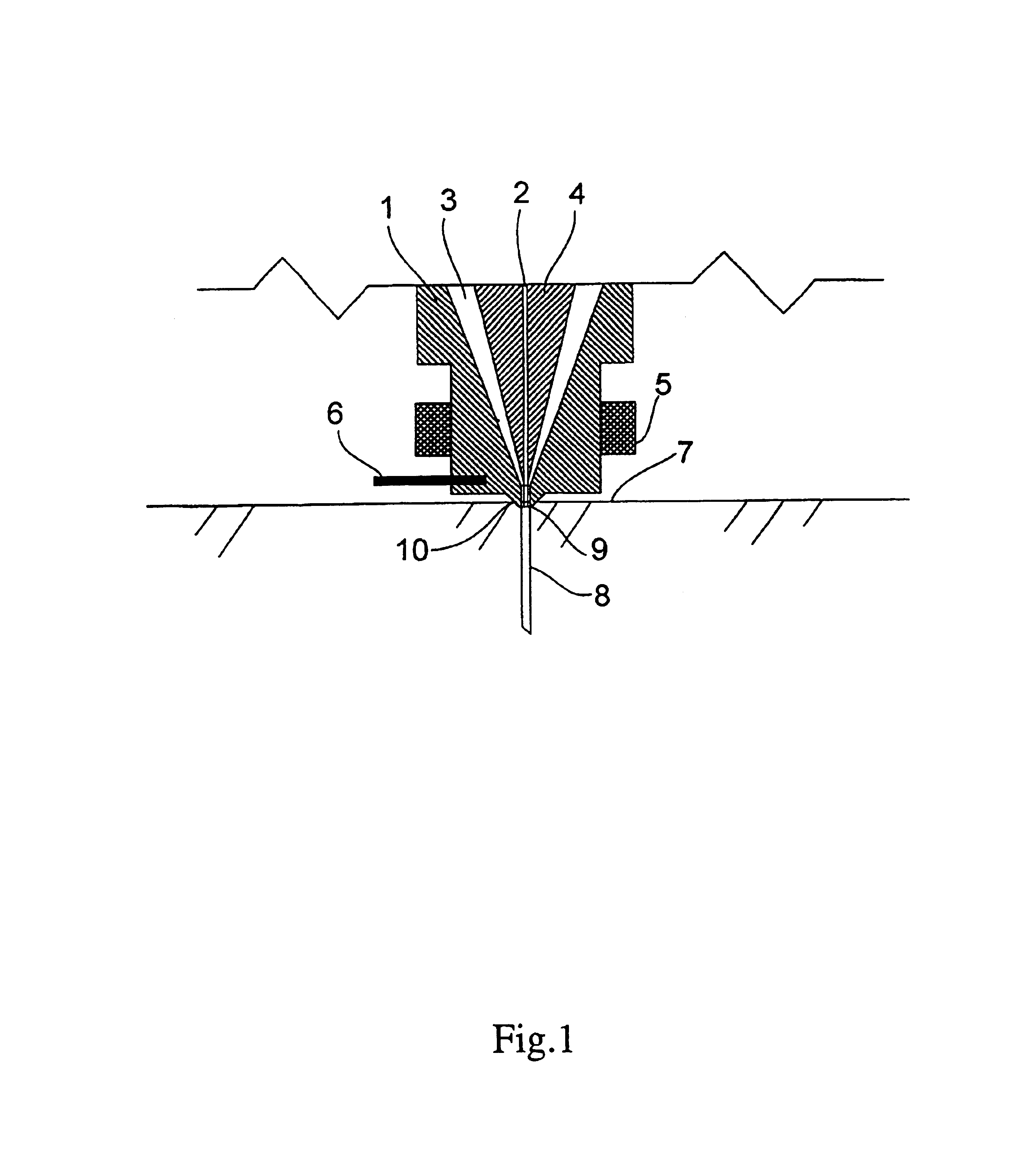Skinned hollow fiber membrane and method of manufacture
a hollow fiber and fiber technology, applied in the field of hollow fiber membrane and method of manufacture, can solve the problems of low porosity and depletion of microporous membrane properties, and achieve the effect of not preventing solvent evaporation and preventing the formation of skin
- Summary
- Abstract
- Description
- Claims
- Application Information
AI Technical Summary
Benefits of technology
Problems solved by technology
Method used
Image
Examples
example 1
[0073]Hyflon MFA® grade 620 (poly(PTFE-CO-PFVAE)) powder obtained from Ausimont USA, Inc., Thorofare, N.J., was used as received. The powder was mixed with HaloVac® 60 solvent from Halocarbon Oil Inc, River Edge, N.J. to produce a paste of 30% by weight polymer solids. The polymer / solvent paste mixture is introduced into a heated barrel of a twin screw Baker-Perkins (Saginaw, Mich.) extruder having 29 mm screws, by means of a Moyno (Springfield, Ohio)progressive cavity pump. The extruder barrel temperatures were set at between 180° C. and 300° C. A Zenith® melt pump (Waltham, Mass.) was used to meter the melt into the special hollow fiber die mentioned above. The die annulus was approximately 300 microns. A low volume flow controller, Brooks Instrument 8744, (Hatfield, Pa.) fed air at controlled rate to maintain the hollow portion of the fiber. The melt pump and air pressure were adjusted to produce a fiber with about a 150 micron thick wall and a 540 micron diameter lumen at a spin...
example 2
[0075]Pellets of Hyflon MFA® 620(Poly(PTFE-COPFVAE)) obtained from Ausimont USA, Inc., Thorofare, N.J., were ground to about 300 micron size and were mixed with HaloVac® 60 from Halocarbon Oil Inc, River edge, N.J. to produce a paste of 40% by weight polymer solids. The polymer / solvent paste mixture is introduced into a heated barrel of a twin screw Baker-Perkins (Saginaw, Mich.) extrudor having 29 mm screws. The extruder barrel temperatures were set at between 180° C. and 285° C. A Zenith melt pump (Waltham, Mass.) was used to meter the melt into the special hollow fiber die mentioned above. The die annulus was approximately 300 microns. A low volume flow controller. Brooks Instrument 8744, (Hatfield, Pa.) fed air at controlled rate to maintain the hollow portion of the fiber. The melt pump and air pressure were adjusted to produce a fiber with about a 250 micron thick wall and a 540 micron diameter lumen at a spinning rate of 100 feet per minute. Dioctyl pthalate, maintained at 35...
example 3
[0076]In this example, water is degassed using a membrane made in a manner similar to the membrane of Example 1. A bundle of fibers was made, potted and installed in a cylindrical holder that separated the lumen side from the shell or outer side of the fibers. The fiber ID was 500μ and the fiber wall was about 150μ The number of fibers was about 500 and the length of the module was about 20 cm. Water, at a temperature of 20° C., was pumped through the fiber lumens and a vacuum of 60 Torr was maintained on the shell side. The oxygen level of the water was measured at the inlet and outlet of the membrane bundle at various flow rates.
[0077]The same module was used for gasification efficiency. In this mode, water at 20° C. was pumped through the lumen just as before, except that the feed water was degassed by a Hoechst Liquid Cel degasser. The shell side was purged with low-pressure air on one end, while the other end was left open. Because of the low gas flow, there was practically no ...
PUM
| Property | Measurement | Unit |
|---|---|---|
| Pore size | aaaaa | aaaaa |
| Pore size | aaaaa | aaaaa |
| Pressure | aaaaa | aaaaa |
Abstract
Description
Claims
Application Information
 Login to View More
Login to View More - R&D
- Intellectual Property
- Life Sciences
- Materials
- Tech Scout
- Unparalleled Data Quality
- Higher Quality Content
- 60% Fewer Hallucinations
Browse by: Latest US Patents, China's latest patents, Technical Efficacy Thesaurus, Application Domain, Technology Topic, Popular Technical Reports.
© 2025 PatSnap. All rights reserved.Legal|Privacy policy|Modern Slavery Act Transparency Statement|Sitemap|About US| Contact US: help@patsnap.com



